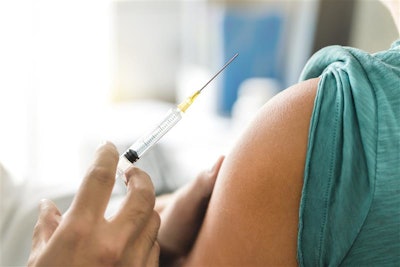
While few would argue that 2020 was more than just a challenge, the outlook for 2021 is beginning to look brighter thanks to promising COVID-19 vaccine developments. But, that promise will only be realized if we can mobilize the collective expertise, technology and distribution networks across an ecosystem of industry, government, logistics and non-governmental organizations to ensure that everyone believes the vaccines have been distributed safely.
For context, according to a recent study by Pew Research Center, 77% of citizens surveyed are concerned a vaccine will be approved before its safety and efficacy are fully understood. And, according to IBM Institute for Business Value consumer research, less than 60% of citizens surveyed globally believe the actions taken by governments in response to the pandemic have been appropriate. To solve these problems and return to some sense of normal, the mounting data and associated actions point to a crucial missing ingredient for success – trust.
What is more, there is reason to believe that the distribution of COVID-19 vaccines will present unprecedented challenges for supply chains that have already found points of failure under the ongoing crisis. If trust is to be restored for successful vaccine distribution, we must prepare for three major distribution challenges for the COVID-19 vaccine—integrity of product, protection against fraud and unity across stakeholders from inception to injection.
A demanding vaccine cold chain
One impediment to rapid distribution is refrigeration. Currently, two promising vaccine candidates need to be maintained at very cold temperatures, one of them at -94°F, colder than the winters in Antarctica and far colder than your household freezer. Major healthcare systems have been buying up ultra-freezers to meet these needs, but at $10,000-$15,000 up front, rural hospitals have begun sounding alarms that these costs are out of reach.
Maintaining these supply chains up to the point of disbursement is critical to maintaining public trust in the vaccine itself. If doses fail, doctors and public health officials must be able to identify when a simple temperature excursion—a temperature reading outside of the prescribed limits—was the cause, a capability that will require investing in an “intelligent supply chain” capable of offering a near-real time view into the supply of goods.
The “last mile” of vaccine distribution also presents a set of unique challenges. As seen with the rollout of the Coronavirus disease (COVID-19) testing, point of care will probably take place in a large variety of institutions, from pharmacies and community centers to hospitals, satellite clinics and doctors’ offices. To coordinate vaccine supply, officials will need access to a platform that can unite diverse, localized vaccine management strategies in a single integrated view.
Patient engagement will also be important, particularly if there is a need to maintain and manage multiple dosing, as some of the vaccine candidates require. This will require proactive scheduling, planning and demand forecasting across thousands of different locations. Public health officials will need to draw on a diversity of methods to alert and engage with citizens, while also working to provide medical records that may interface with state-owned systems. Personal information and immunization records must also be carefully maintained according to health information laws and regulations. And, should the very unfortunate outcome happen, where someone that has been administered the vaccine still contracts COVID-19, there will be a dire need for unquestionable and trusted data. Was the vaccine “bad”? Was it administered improperly? Where was it stored, administered, shipped and by whom?
Protecting against counterfeit and fraud
Unfortunately, bad actors have remained unscrupulous in exploiting the pandemic for financial gain, and counterfeits of COVID-19-related goods like faulty masks and hand sanitizer have remained common. The FDA recently issued a warning to consumers about how to spot fake “miracle cures.” Particularly in regions around the world with fewer regulations and less public health resources, preventing medical fraud will continue to be a challenge.
The supply chain must also be made resilient against cyberattacks as well. The National Security Agency and the Cybersecurity and Infrastructure Security Agency recently warned that the pandemic has created additional security risks for the supply chain, from the prevalence of employees working at home on potentially unsecure servers, to the increased use of remote monitoring to the large variety of vendors with different security standards and vulnerabilities. Canada has already warned that hackers are working on new ways to target electricity and critical infrastructure. Without adequate safeguards, hackers could in theory target Internet of Things (IoT) beacons—small wireless sensors that send information about factors such as temperature to a central database—monitoring vaccine cold chains or use other targeted efforts to undermine distribution or sow chaos.
This information and level of threat is not necessarily new. However, the effects of a global pandemic have brought a new appreciation of the risk and potential impacts.
Bringing the pieces together
To eradicate polio from the United States, a large-scale public and private partnership came together to work toward a common goal, from universities and pharmaceutical manufacturers to local public awareness campaigns and school districts.
To do the same for COVID-19, we will once again draw on the expertise and resources of pharmaceutical companies, technology companies, federal, state and local governments, the non-profit sector and more. And, for this to happen, manufacturers, distributors, dispensers and citizens must all have some assurance they are informed by and maintaining a shared and transparent truth.
Building trusted information exchanges at scale is possible thanks to technologies like hybrid cloud, IoT and blockchain. These technologies allow organizations to better cooperate and share information across a multitude of different computing environments. Together, these tools make it possible to bridge platform differences, allowing organizations of all sizes to work together toward a common goal.
While there is certainly reason to be optimistic about this spring, we must also be vigilant about the challenges that remain, from overcoming the fatigue after months of quarantines to rebuilding our businesses and economy back to their former heights. Central to overcoming all of these challenges will be ensuring safe access to a trusted vaccine. A smart supply chain, bolstered by advanced technology, can help make that happen.




















![Pros To Know 2026 [color]](https://img.sdcexec.com/mindful/acbm/workspaces/default/uploads/2025/08/prostoknow-2026-color.mduFvhpgMk.png?ar=16%3A9&auto=format%2Ccompress&bg=fff&fill-color=fff&fit=fill&h=135&q=70&w=240)
